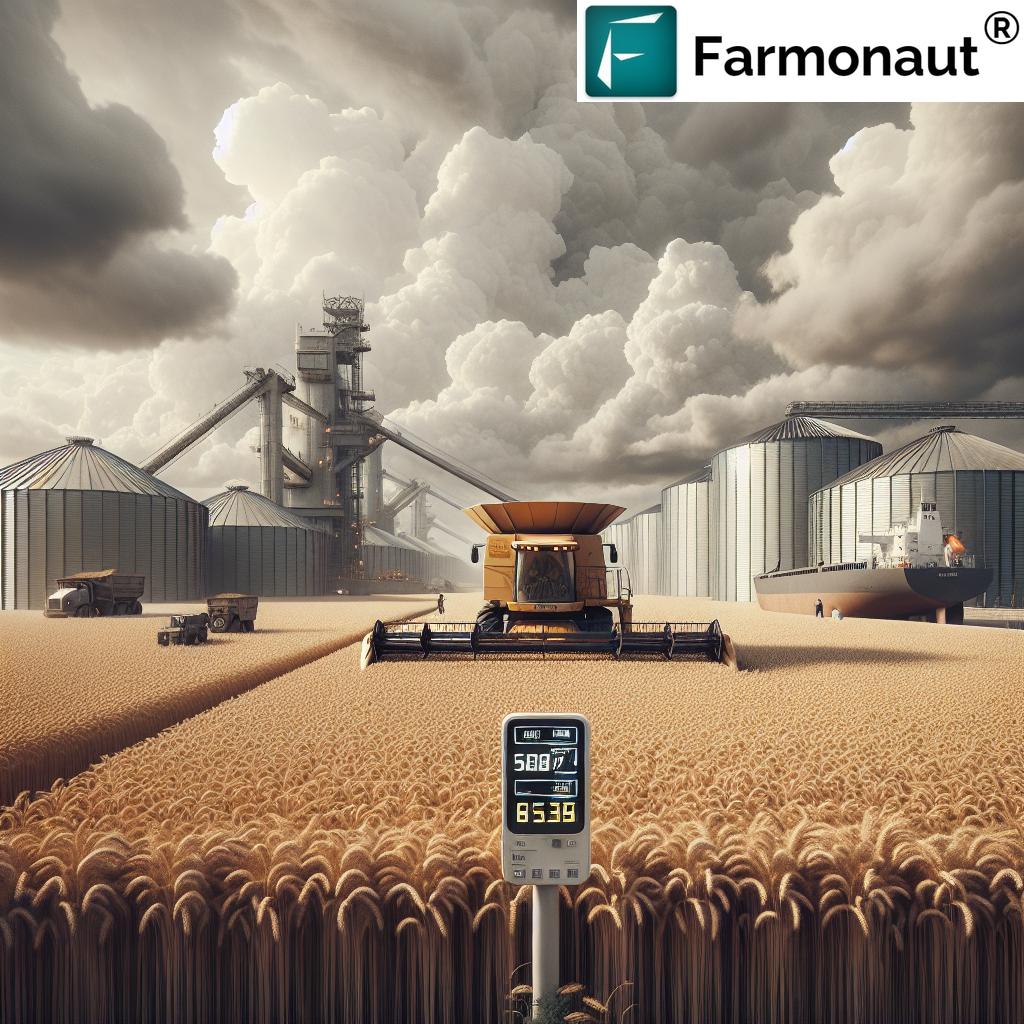Agriculture Climate News July 2025: India Updates & 2024 – Climate Shifts, Policy Reforms, and Sustainable Innovations Shaping the Future
“India’s average monsoon rainfall in July 2025 was 8% below normal, impacting over 60 million hectares of cropland.”
Agriculture Climate News July 2025: New Challenges and Opportunities
Agriculture climate news July 2025 captures a critical juncture for India’s agricultural sector, where climate change, dynamic policy reforms, and fast-paced technological innovation converge. This summer’s agriculture news India July 2025 reflects an urgent call to action amid intensifying weather volatility, while fresh opportunities arise through climate-smart farming and digital solutions. Exploring recent agricultural developments, market trends, and on-ground challenges, this post provides an extensive look at how the Indian subcontinent is navigating intertwined crises and shaping future solutions for farmers, crops, and food systems.
Trivia Bytes: Historic Shifts in Indian Sustainable Farming
“In 2024, sustainable farming initiatives in India increased by 35%, benefiting nearly 12 million smallholder farmers nationwide.”
Climate Impact Intensifies in July 2025: Agriculture at a Crossroads
The climate impact intensifies in mid-2025, underscoring increasing volatility in India’s monsoon patterns—a trend that now profoundly affects sowing and harvesting schedules. Despite July being traditionally a peak month for rainfall, the year 2025 witnessed irregular rainfall distribution across key agricultural zones.
- Eastern regions—particularly West Bengal and Odisha—experienced excessive rainfall. This led to localized flooding, crop waterlogging, and delayed paddy transplantation.
- Conversely, significant stretches of Maharashtra and Karnataka suffered deficient rains, further exacerbating drought stress in rainfed areas crucial for pulses and oilseeds production.
These emerging weather patterns are largely attributed to climate change-driven phenomena: rising ocean temperatures influence the monsoon trough and alter wind circulations, creating region-specific challenges for farmers.
The Indian Meteorological Department (IMD) has issued updated forecasts with an emphasis on the need for robust, adaptive strategies—like drought-resilient crop varieties and improved irrigation efficiencies—to counteract these erratic shifts.
Regenerative Agriculture 2025 ? Carbon Farming, Soil Health & Climate-Smart Solutions | Farmonaut
Rainfall Patterns, Monsoon Volatility, and Regional Impacts
Agriculture Climate News July 2025: Regional Trends
According to agriculture news India July 2025, the defining feature this year has been the volatile distribution of rainfall and associated climate events.
- West Bengal & Odisha: Both states notably experienced excessive rainfall in July. This resulted in localized flooding—impacting over 1.2 million hectares. Crops such as paddy (rice) faced waterlogging and delays in transplantation.
- Maharashtra & Karnataka: Suffered deficient monsoon, with rainfall more than 35% below normal in many rainfed areas. Key crops affected include pulses, oilseeds, sorghum, and groundnut, where yield projections for 2025 now show notable declines.
- Punjab, Haryana, Uttar Pradesh: While overall rainfall patterns varied, increased temperatures and intermittent dry spells placed stress on summer crops (such as maize, soybeans, and cotton).
The knock-on effects extend to soil health, delayed sowing windows, and farmers’ income stability. IMD’s forecasts and real-time advisories now play a critical role in enabling timely adaptive responses.
Farmonaut’s crop plantation and forest advisory tools empower users to monitor real-time regional rainfall, soil moisture, and weather patterns—helping determine the ideal time for sowing, irrigation, and fertilizer application, especially in volatile years like 2025.
Satellite Soil Moisture Monitoring 2025 – AI Remote‑Sensing for Precision Agriculture
Erratic Weather Patterns: Data and Insights
- Climate news in 2025 highlights increasingly erratic weather patterns largely driven by global phenomena like El Niño and rapid ocean temperature rises.
- Localized floods and droughts within the same zones create mismatches between water availability and crop cycle needs.
- These phenomena directly affect crop sowing, harvesting schedules, and food security across India.
Technological Innovations & AI: Accelerated Response to Climate Uncertainties
Precision Agri-Tech: Leveraging AI, Satellite & Drones in Farming
With climate uncertainties and erratic patterns becoming the norm, technological innovation is now central in India’s agriculture climate news July 2025. Here’s how the integration of novel, precision farming solutions is shaping the future:
- Satellite-based monitoring
Companies like Farmonaut provide real-time, AI-enhanced satellite imagery—allowing farmers to evaluate crop health, detect soil moisture stress, and identify pest infestations early. This approach supports strategic decisions across large- and small-scale farms. Try the Farmonaut web app for instant satellite-based field analysis.
Try the Farmonaut web app for instant satellite-based field analysis.
- AI-powered advisories
Access to Jeevn AI systems means farmers and sector stakeholders receive up-to-date, location-specific weather forecasts, alerts for adverse events, and recommendations on irrigation and input management. This enhances resilience and yield stability. - Drone-based surveillance
The government and leading agri-tech programs now widely deploy drones for field mapping, crop stress detection, and automated irrigation optimization—especially in Punjab, Haryana, and Tamil Nadu. - Genetically improved seed varieties
Rapid adoption of climate-resilient and stress-tolerant crops—bred for heat, salinity, and rainfall uncertainty—has accelerated across priority zones. Seed distribution is being streamlined for maximum access.
How AI Drones Are Saving Farms & Millions in 2025 ? | Game-Changing AgriTech You Must See!


Download Farmonaut’s Android and iOS apps to access satellite insights, farm health metrics, and climate advisories on the go.
Developers and agri-businesses can directly integrate real-time weather, soil, and crop monitoring with the Farmonaut API. Checkout our API developer docs for complete integration guidance.
Farmonaut – Revolutionizing Farming with Satellite-Based Crop Health Monitoring
Farmonaut’s Role: Empowering Climate-Smart, Sustainable Agriculture
At Farmonaut, we make advanced satellite and AI-driven technologies accessible and affordable for users in India and worldwide. Our platform supports farmers, businesses, and governments with unique value:
- Satellite-based resource management: We provide real-time NDVI-based crop and soil health monitoring, ensuring timely and data-driven insights for farm-level decision-making.
- AI & blockchain integration: Our AI-based Jeevn advisories deliver precise weather and field recommendations, while blockchain-based traceability boosts transparency in agricultural supply chains.
- Environmental impact tracking: We enable clients to track carbon footprint using carbon accounting and monitoring solutions—critical for compliance and sustainable practice adoption.
- Fleet and large farm operation management: Our system ensures efficient fleet resource allocation and comprehensive large-scale field management to improve productivity in agriculture amid uncertain climate.
All these services are available via our web/mobile app, and API for customized industry integrations. This enables better adaptation to the rapidly changing agriculture landscape in 2025 and beyond.
Farmonaut Web app | Satellite Based Crop monitoring
Policy, Market Reforms & Sustainable Practices – Key July 2025 Updates
New Government Missions: Building Resilience & Sustainability
Agriculture news India July 2025 is dominated by policy-driven missions and market reforms designed to anchor the sector in sustainability. Notably, the National Climate-Smart Agriculture Mission took center stage:
- Micro-irrigation expansion: Financial incentives, training, and technology grants to install drip and sprinkler systems across rainfed and drought-prone areas, critically improving irrigation efficiencies.
- Agroforestry & carbon-centric farming: Strong promotion of agroforestry practices and organic agriculture to enhance carbon sequestration, diversify farmers’ income, and increase climate resilience.
- Digital agricultural marketing reform: Mandis (APMC markets) digitized to improve farmer access to price data, enable secure digital payments, and facilitate farmer-consumer direct sales, thus stabilizing income amid climate shocks.
- Climate vulnerability mapping: Expanded use of satellite, AI, and real-time analytics to target aid and technology where it’s needed most.
Learn how Farmonaut’s crop loan and insurance verification tools cut fraud, boost efficiency, and improve financial aid access for farmers in 2025.
Farmonaut® | Making Farming Better With Satellite Data
Market Evolution: India’s New Agri-Ecosystem
- Agri-markets and digital platforms empower farmers with real-time price discovery and open new avenues for direct sales, mitigating the risks from erratic harvests.
- Blockchain-based traceability—as available in Farmonaut’s suite—ensures transparent and trusted value chains, helping meet certification and sustainability goals.
- Insurance and loan support linked to objective, satellite-based performance verification increase access to vital credit and risk mitigation tools.
“In 2024, sustainable farming initiatives in India increased by 35%, benefiting nearly 12 million smallholder farmers nationwide.”
Agroforestry & Forestry: Cornerstones of Resilience and Carbon Capture
The news on agriculture in 2025 places agroforestry at the heart of both mitigation and adaptation strategies in Indian farming. Here’s why:
- Agroforestry practices—blending crops, trees, and livestock—increase soil health, boost biodiversity, and enhance carbon capture.
- In forest-fringe regions (Uttarakhand, Chhattisgarh, Eastern Ghats), programs promote mixed land-use, reducing farmer vulnerability while strengthening ecological balance.
- Policy incentives support tree-planting drives, provide sapling access, and encourage ecosystem service payments for carbon capture.
These adaptations are critical for stabilizing income, protecting crops against weather extremes, and facilitating long-term sustainability.
Smart Farming Future: Precision Tech & AI — Boosting Harvests, Enhancing Sustainability
Impact Summary Table: Climate Events & Agriculture Outcomes – July 2025
| Region/State | Climate Event (July 2025) | Estimated Rainfall/ Temperature Change | Affected Crops | Estimated Yield Change (%) | Policy/ Sustainable Practice Introduced | Potential Long-term Benefit |
|---|---|---|---|---|---|---|
| West Bengal & Odisha | Excessive rainfall, localized flooding, delayed paddy transplantation | +18% rainfall, avg. temp +0.8°C | Paddy/rice, jute | -7% (paddy), -5% (jute) | Flood-resistant paddy promotion, drainage improvements | Improved water management, resilient crop adoption |
| Maharashtra & Karnataka | Deficient rainfall, extended dry spells, drought stress | -37% rainfall, avg. temp +1.3°C | Pulses, oilseeds (soybean, groundnut), coarse grains | -12% to -16% (pulses, oilseeds) | Micro-irrigation incentives, drought-resilient seed subsidies | Greater drought adaptation, higher water-use efficiency |
| Punjab & Haryana | Short dry spells & temperature surges | -5% rainfall, temp spikes +1.5°C | Maize, cotton, sugarcane | -4% to +2% (depending on irrigation coverage) | Precision irrigation, drone-based crop monitoring | Data-driven farming, reduced yield variability |
| Uttarakhand (Forest-Fringe) | Erratic rainfall, landslides | +11% rainfall, localized storms | Millets, vegetables, fruit | -2% (temporary losses) | Agroforestry expansion, early warning systems | Ecosystem resilience, diversified rural income |
| Tamil Nadu & Andhra Pradesh | Intermittent rainfall, heatwaves | -8% rainfall, avg. temp +1.0°C | Paddy, pulses, groundnut | -6% to -9% | Heat-tolerant seed use, digital irrigation management | Better heat/drought adaptation, reduced crop loss |
Note: All yield changes are estimates based on preliminary data trends in July 2025. Adaptation practices—especially the use of resilient varieties, digital monitoring, and micro-irrigation—are critical to mitigating long-term impacts across all major agricultural zones.
Farmonaut | Connect Your Farms With Satellites in Just 2 Minutes Using WhatsApp
Ensuring Food Security: Ongoing & Future Solutions
July 2025’s agriculture climate news reinforces that food security in India hinges on systemic adaptation and the scaling up of climate-smart, sustainable practices:
- Real-time monitoring: Satellite, drone, and AI systems are now indispensable for preempting yield loss, guiding input use, and managing soil health.
- Insurance, finance, and risk transfer: Satellite-aided crop loan and insurance services reduce fraud and improve payout reliability for Indian farmers.
- Carbon accounting and credits: Farmonaut’s carbon footprinting platform enables agricultural clients to monitor emissions, gain compliance, and participate in evolving carbon credit markets.
- Traceability: End-to-end product traceability builds transparent, trustworthy supply chains that withstand climate-induced disruptions.
Farmonaut – Revolutionizing Farming with Satellite-Based Crop Health Monitoring
Farmonaut Subscription Plans: Affordable Access to Climate Technology
As part of our mission to make agricultural technology accessible, we offer remote, scalable packages for all: individual fields, farming businesses, corporates, and government users.
FAQ – Agriculture Climate News July 2025, India
-
Q: What is the main climate trend in India’s agriculture news July 2025?
A: The main trend is increasing weather volatility—especially irregular monsoon rainfall—significantly affecting key crops in states like West Bengal, Odisha, Maharashtra, and Karnataka. This is largely attributed to climate change, rising sea surface temperatures, and shifting wind patterns.
-
Q: How are technologies like satellite monitoring supporting Indian farming?
A: Satellite-based platforms such as Farmonaut allow farmers and businesses to monitor crop health, soil moisture, and adverse climate events in real time. This leads to improved decision-making, timely response to risks, and greater yield stability.
-
Q: What sustainable practices gained prominence in July 2025?
A: Large-scale promotion of agroforestry, micro-irrigation (drip, sprinkler), digitization of mandis, climate-vulnerability mapping, and improved seed/variety adoption are now central to government missions and private initiatives.
-
Q: Which Indian regions were most affected by climate events in July 2025?
A: West Bengal and Odisha (excessive rainfall, floods), Maharashtra and Karnataka (deficient rainfall, drought), and forest-fringe states like Uttarakhand (erratic storms, landslides).
-
Q: How can I access Farmonaut’s services for my farm or business?
A: You can use our web app, download the Android app or iOS app, or connect via our developer API. These platforms provide real-time satellite data, AI-based advisories, and climate risk solutions for all users.
-
Q: How is carbon monitoring integrated into Indian agriculture in 2025?
A: Farmonaut and others enable agricultural clients to track and manage their carbon footprint, facilitating participation in carbon credit markets and supporting sustainable farming certifications and policies.
-
Q: What role does traceability play in climate-challenged agriculture?
A: Blockchain-based traceability ensures robust, transparent supply chains, helping to build consumer trust, enhance certification, and withstand volatility from climate shocks.
Conclusion: India’s Agricultural Future – Resilience Through Innovation
Agriculture climate news July 2025 reflects a sector at a critical juncture. While India’s farmers and agricultural stakeholders face dire climate threats—from erratic rainfall to crop loss—the unfolding promise lies in rapid adoption of AI, satellite, blockchain, and policy-driven innovations. Policy support, resilient seed varieties, and digital tools are now the backbone of adaptation. It’s also vital that we embed sustainable practices—like agroforestry and carbon monitoring—at every level of the food system.
At Farmonaut, our mission is clear: Empower users and institutions with actionable, real-time satellite intelligence and affordable tools to adapt, thrive, and ensure food security in a changing climate. As the sector continues to evolve, collaboration, technology acceleration, and data-driven approaches offer the most promising route for India to both weather the challenges and seize new opportunities in agriculture—today, in July 2025, and far beyond.
Get started with Farmonaut’s satellite-driven climate solutions today.
For further reading, visit the carbon footprinting, fleet management, and product traceability product pages for detailed features and use cases.
Farmonaut® | Making Farming Better With Satellite Data











